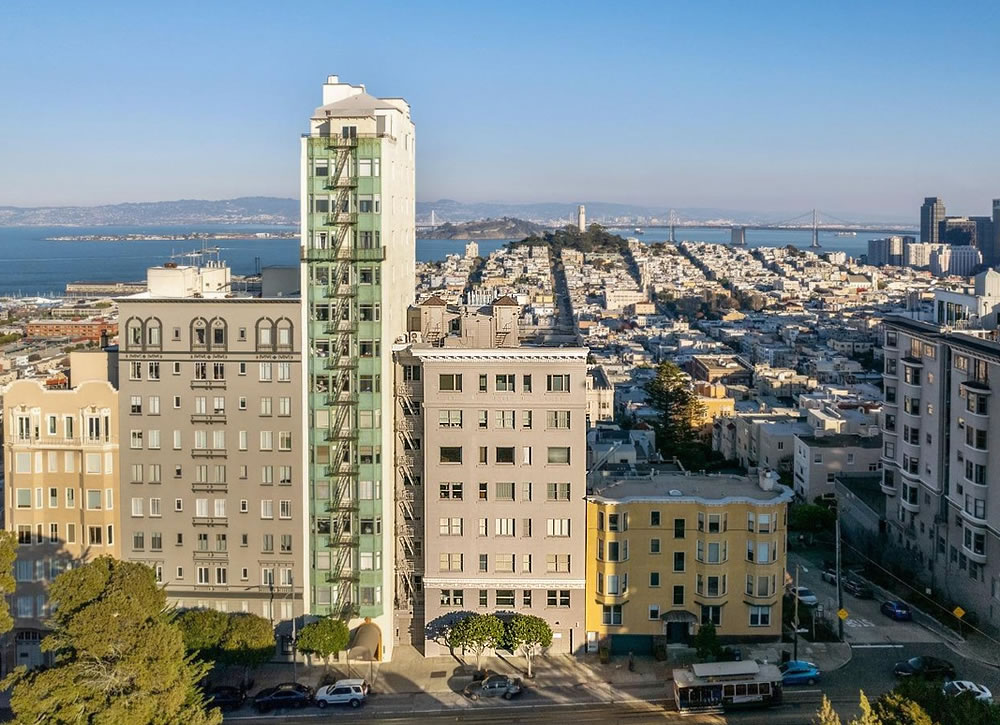Purchased for $2.94 million in April of 2006, which was $310,000 “below asking” at the time, the 2,770-square-foot, full-floor cooperative unit #1 in the boutique 7-unit Russian Hill building at 2222 Hyde Street, which offers sweeping panoramic views from every floor, returned to the market priced at $3.395 million at the beginning of this year, a sale at which would have represented net appreciation of just 15.5 percent for the top-tier unit since the second quarter of 2006 or roughly 1 percent per year.
Relisted for $2.995 million in early September, having failed to secure an acceptable “over asking” offer despite having been dropped to $2.75 million in June, the list price for the prestigious view unit in a rather established San Francisco neighborhood was slashed to $2.5 million at the end of September and the re-sale of 2222 Hyde Street #1 has now closed escrow with a contract price of $2.35 million, which is officially “within 6 percent of asking!” according to all industry stats and aggregate reports but 20.3 percent below its value in 2006 on an apples-to-apples basis.












Well, maybe the cooperative board mandated that this seller make more than a 20 percent down payment in April 2006 when they purchased, so unloading this will be less painful financially than it appears at first glance.
If you think that $1K per ft.² “for a very nice, refreshed, desirable floor plan condo with sweeping views of the Bay” is “extremely low”, then this sale, at $848 per ft.² should either be an outlier or a harbinger of doom (at least for co-op units).
WHy would losing 20%, plus all the additional costs be any less painful because they put down a 20% down payment?
Well, I didn’t bother to work out whether or not the amount of an 80 percent loan still outstanding this month would exceed the sales amount, but my thought was that if the seller put down a more substantial down payment, then they wouldn’t have to bring such a large check to the closing.
Yep. this one takes the cake…for now. Maybe there’s something challenging about this Co-Op. $2,979 monthly HOA fee doesn’t help.
Last time this property came up here, during the Summer, sockettome said:
Well this comp is definitely not going to help all the +$900/sqft units lingering on the market. Time to make those price cuts!
Very nice…and with garage parking.
Is there a practical difference between a co-op and a TIC? I understand that a co-op is a corporation and a TIC is not, but how does that affect living in one vs the other? Is there a difference in the cost/availability of debt ? TICs tend to have a stigma while co-ops have an aura of exclusivity. Is there anything stopping a TIC from converting to a co-op, or from converting to an apartment to co-op instead of TIC?
Some of this is customary rather than legally required, but typically co-op boards require far more extensive approval for any purchaser, may forbid owners from renting the units for more than a few years (or ever!), they can choose to allocate common charges however they want (not just based on square footage), can apply fees on any resale (and in NYC, they often add a “flip tax” on any short term resale), and get far more nosy into how people finance their homes. From valuation perspective, I would much rather own a TIC than a Coop.
Sounds like communism for the rich.
BolshevismButtinskismWe do have communism for the rich in the U.S.A. The problem, however, is that its application seems to be restricted to those who work on Wall Street or for rich bankers. Everyone else gets laissez-faire capitalism, market forces, red in tooth and claw.
I don’t know of any existing in S.F., or even if California’s property laws enable and support such a thing, but in New York City, they have Housing Development Fund Corporation co-ops for for the decidedly non-rich. Units in some of the buildings are owned by the formerly homeless or completely under-housed.
Most existing NYC H.D.F.C. co-ops are income-restricted buildings converted in the 1970s and ’80s (i.e., when NYC was suffering from white flight) and many of the buildings were abandoned. These restrictions are income caps precisely intended to keep the apartments affordable, as well as income ceilings for potential buyers upon resales, in addition to hefty “flip-tax” provisions that “asdf asdf” mentioned above, to help deter anyone looking to make a quick profit (the proceeds from which go back into building coffers for roof repairs, facade work and other maintenance issues).
I realize that kinda thing’s anathema for the flippers, mom and pop landlords, real estate agents and other hangers-on in the S.F. real estate “game” that regularly read this site and think of housing as an asset which facilitates the increase of their personal wealth. If you’re in that category, you could indeed call this communism; the municipal government straight-up seized most of the subject properties in the late ’70s, began fixing up the buildings, then allowed tenants to buy them for nominal amounts and turn them into low-income co-ops.
San Francisco could try the same tactic with vacant bank-owned office buildings downtown that will be readily available in the next few years. And yes, convert some of them with amenable floor plates to housing, when the residual land value of the target buildings decrease to an appropriate level. Beats having them sit empty for years on end.
Co-op. A co-op is where the building is owned by a corporation. When you buy into a co-op, you’re buying shares in the corporation that give you the right to live in “your” apartment. Co-op boards are notorious for using their control to ensure that only “their kind of people” – however the board defines it – can buy into the building. Here’s a hilarious op-ed my former SF neighbor wrote complaining about the vagaries of buying into a co-op. https://www.nydailynews.com/2022/07/10/a-headache-wrapped-in-a-nuisance-inside-an-abomination-the-trouble-with-coops-in-nyc/
Condo. When you buy a condominium, by contrast, you’re buying the actual property rights to your unit. No one can tell you to whom you can sell. All the condo owners jointly own the common areas. San Francisco highly restricts new condominium construction and conversions to condominium.
TIC (Tenancy in Common). When you buy a TIC, you buy a portion of an entire building. Most of your rights are determined by the contract among the owners. Because it’s fractional ownership of a building, there are fewer lender and the terms are worse. We had friends buy into a TIC in the late 80’s. They won the condo conversion lottery, but for some reason, one of the three tenants didn’t want to convert to condos, so they never did. They could not sell the TIC for a price they found acceptable (probably because the disputes among the owners turned into lawsuits and were public record), so they ended up renting out the TIC and living in a rental apartment themselves to get away from the neighbor.
So, you buy into a coop because you think you’re the “right” kind of person and you count on the board to ensure that all of your neighbors are also the “right” kind of people. Basically, this is if having a say in who your neighbors are matters to you. You buy a condo if you want apartment living but want to own the apartment. Catch is, there aren’t that many in SF and SF doesn’t make it easier to make more. Finally, TIC is the rest of joint owning a multi-unit building.
As to the various conversions, whether you can convert a TIC to a co-op would depend on the underlying TIC contract among the owners. You wouldn’t convert a TIC to an apartment because you own a TIC and you rent an apartment. And you can’t convert a TIC to a condo unless you win the condo lottery because SF wants to restrict the number of TICs converting to condos.
Ouch!
Primary suite on the second floor, just above the building garage door and overlooking a cable car … good luck sleeping
Weren’t both of those the same in 2006? Also… the cable car runs 7am-10pm (3 times an hour in morning and evening).
I’d sleep just fine.
$2.35M was paid in 2023 dollars, which were worth $1.54M 2006 dollars. The seller paid $2.94M in 2006 dollars, so the buyer paid about 47.6% less than the seller, not 20.3%.
Case Shiller is sort of a bad graph, but because it’s all we have, let’s look at when this property was worth 47.6% less than 2006. The index was 218 in Apr 2006, so 0.524*218 is 114.2. (0.524 =1.0 – 0.476) May of 2000. That’s where this sale landed (I think C-S builds in its own inflation adjustment, so no further adjustment need be made).
Easy come, easy go.
Sweeping views?
The sweeping view is from the rear side – remember, this is (one of)the top(s) of Russian Hill.
What would the owner have paid in monthly rent on this place? What were the tax savings? Those are some key details to know before working out the finances of this property.
2.94M in 2006 would be 4.48M in today’s dollar. Selling it for 2.35M today looks pretty painful especially when taking inflation into consideration. Ouch. Hope seller had a great time living there.